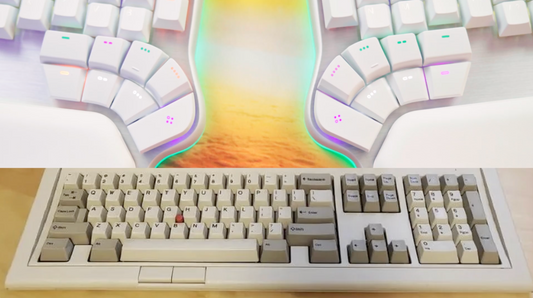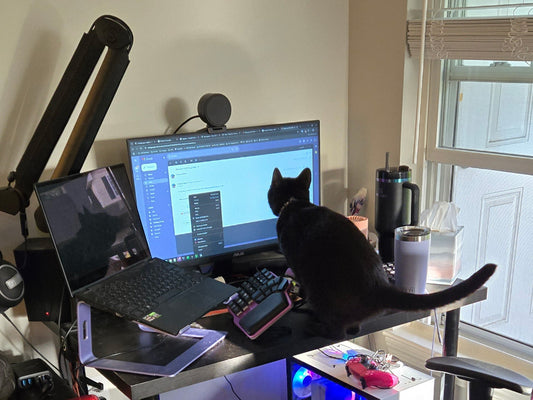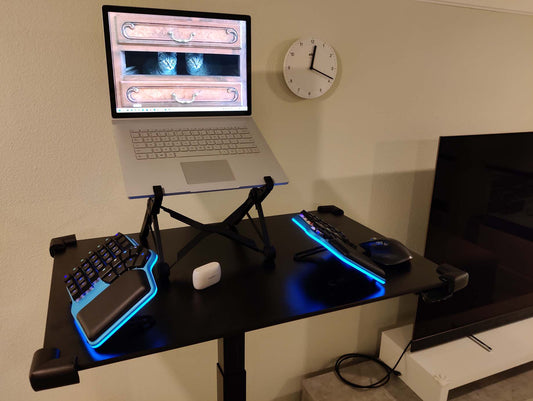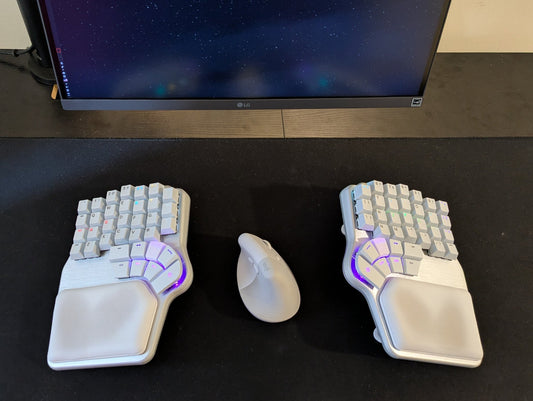When we design a keyboard, every decision is based on months of research, prototyping, and internal debate. Nothing is random; every curve, switch, and angle has a reason behind it.
But even so, we still get many questions about why we made certain design choices.
Our CEO, Luis, joins us to explain some of the most common ones, from thumb clusters to palm rests, from the Neuron to our tenting system.
Why does the Defy have so many thumb keys?
When designing the Defy, we tested it with numerous users, using different hand sizes, arm angles, and typing styles. We learned that the position and range of the thumb vary greatly from person to person.

That’s why we designed our thumb cluster with several thumb keys: to offer options for everyone. Some people may find the inner keys more comfortable, while others prefer the outer ones.
And for those with more flexible thumbs, five or six keys feel natural. You don’t have to use them all, just the ones that fit your anatomy best.
You can learn how we develop the thumb cluster more deeply in the following video.
Why not add a modifier row below the thumbs?
From an ergonomic perspective, using the pinky to press lower-row modifiers like Ctrl or Alt forces your wrists into awkward angles. That’s why we moved modifiers to the thumb cluster.

This lets you press combinations like Ctrl + Shift + Alt with a single thumb, keeping your hands relaxed on the home row. It’s more natural, more efficient, and simply more comfortable for long hours of typing.
Learn all about layers by watching this video:
Why aren’t the palm rests detachable?
We decided not to make the palm rests detachable for two reasons, both of which are rooted in ergonomics.
First, wrist posture. The integrated palm rests help your wrists stay at a neutral angle while typing. If they were removed, your wrists would rest directly on the desk, bending down toward it. Over time, that wrist extension can lead to discomfort or strain, especially during long typing sessions.
Second, tenting comfort. When you tent the keyboard, fixed palm rests become essential. Without them, your hands would “float” above the keyboard, forcing your shoulders and neck to stay tense. To compensate, you’d have to raise your chair or adjust your entire setup, and that’s far from ergonomic.
So yes, detachable palm rests would save a bit of space, but the trade-off is significant: less comfort and worse alignment when tented. The right choice was clear for us: integrated palm rests that keep your hands supported and relaxed, no matter the angle.

Why soft silicone palm pads instead of wood or plastic?
We tested multiple materials for the palm pads: hard, soft, dense, and flexible. After months of testing, we found that a slightly soft silicone surface offers the perfect balance of comfort and durability. It’s soft enough to cushion your palms, but firm enough to provide support.
Yes, hard materials like wood would have been easier to manufacture. But typing for hours daily on a hard surface simply isn’t comfortable. That’s not the Dygma way.

Why do we use the Neuron?
The Neuron is the brain of our keyboards. It allows us to avoid a “master-slave” setup, meaning neither half of the keyboard is dominant. Both sides connect to the Neuron, which handles communication via cable, RF, or Bluetooth.
This makes our keyboards fully ambidextrous and modular. Whether left- or right-handed, you can disconnect one side, use it wirelessly, and still enjoy a stable connection. It’s a more complex system, but it’s the only way to deliver the desired experience.
If you want more information about this, you can check the following video, where we explain it more deeply.
Why mix MX and low-profile switches?
The Defy uses MX switches for most keys, but low-profile Choc switches for the bottom row of the thumb cluster. This design prevents accidental presses when using the thumbkeys. You can press the upper or lower key independently without interference.
It required extra engineering and a second PCB layer, but it was worth it for its precision and comfort.

Why didn't we use south-facing switches?
We use north-facing LEDs for two key reasons.
First, to prevent light from shining directly into your eyes from the bottom row of keycaps.
Second, ensure you can always see your key legends clearly, even when your fingers rest naturally on the keys. It’s a small detail, but it makes a big difference.

What's the underglow for?
It looks great, sure, but it’s also practical. Each layer of your keyboard can have a different underglow color, allowing you to recognize which layer you’re on through peripheral vision. This is especially useful while learning your layout or switching between layers quickly.
In short, underglow isn’t just eye candy, it’s visual feedback.

Why remove the F-keys, arrows, and numpad?
This is one of the most frequently asked questions we receive. The answer is simple: ergonomics and efficiency. Traditional full-size keyboards force you to move your hands far from the home row to reach those keys.
With our layer-based design, you can access your arrows, F-keys, and numpad faster and more comfortably from the home position. It may take a little relearning, but once you get used to it, you won’t want to go back.
Become a pro on Bazecor and configure your keyboard exactly for your needs! How? Watch this video!
Why change the tenting system?
The original Raise had a heavy metal plate for tenting. It was extremely sturdy but bulky and limited to 45°. With the Defy and Raise 2, we wanted something lighter, slimmer, and more flexible.

Our new system offers angles from 5° to 60°, plus reverse tilt options. It’s not as tank-like but more functional, elegant, and portable. You don’t need a brick to type; you need flexibility.
If you want to know more about how the Dygma Raise 2 tenting was made, watch this video:
Every single design decision comes down to one guiding principle: what’s best for the user’s ergonomics and comfort. Sometimes that means more complexity, more prototyping, or more cost, but it always means a better typing experience.
If you have questions we didn’t cover, email us at support@dygma.com, or join the conversation on Discord or Reddit.









